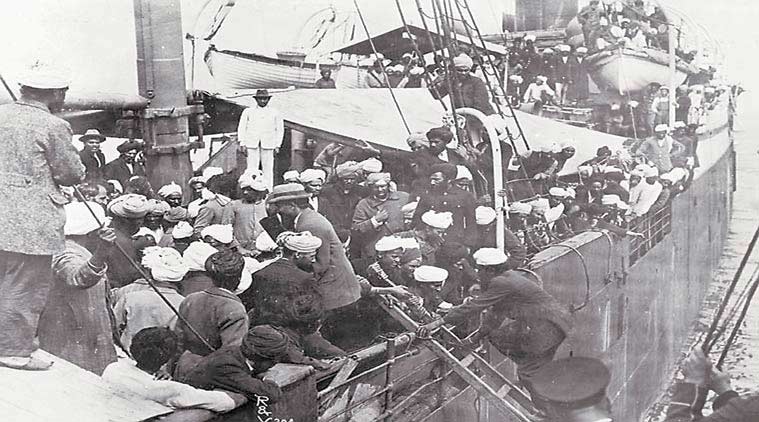Over a century ago, on May 23, 1914, a cargo steamship named Komagata Maru sailed into Burrard Inlet in British Columbia, Canada, on which Vancouver harbour is located. The vessel was owned by a Japanese company and chartered by a Singapore-based businessman named Gurdit Singh. On it were 376 passengers from Punjab — 340 Sikhs, 24 Muslims and 12 Hindus, who had come aboard in batches at the ship’s departure at Hong Kong on April 4 of that year and, subsequently, in Shanghai and Yokohama.

The authorities at Vancouver, however, refused to allow the passengers to disembark. For two months, agitated negotiations took place between the passengers and Canadian immigration officials, during which the passengers endured extreme hardship and near starvation. “We are in great disappointment and miserable conditions. There are five children and two women on board who are quite unable to move for want of water and food,” passengers wrote to the Vancouver Daily News Advertiser.
Story continues below this ad
On July 23, the Komagata Maru was finally turned away, with all except 24 passengers — who were allowed to enter Canada — still on board. The ship made its way back to India, and docked at Budge Budge on the Hooghly near Calcutta on September 27. The British government saw their act of travelling to Canada as revolutionary and seditious, and after a scuffle with passengers, police shot dead 19 of them. Many others were jailed.
[related-post]
Why were the Indians not let in?
By the beginning of the 20th century, it was not uncommon for Indians to travel and settle abroad, and Punjabis, in particular, had developed a capacity to finance their journeys. Around 1910, a large number of Punjabis had settled in Canada — and as they tried to get relatives to join them, the Canadian government came up with exclusionary laws to restrict immigration from Asia. Under a “continuous journey regulation”, immigrants who had not arrived in Canada by a continuous, non-stop journey from their native countries, were denied entry. And while the laws never explicitly restricted the entry of Indians, they made it virtually impossible for Indians to emigrate, because there was no direct route from India to far-off Canada then. (The Komagata Maru had arrived from Hong Kong.)
But why did the Canadians want to keep out Indians (and other Asians)?
Racial prejudice was always a factor, which was inflamed further by the increasing competition for jobs as a result of largescale Asian migration. Vancouver saw largescale anti-Japanese riots in 1907.
Story continues below this ad
But a more important — and historically relevant — reason for keeping out the migrants was the rapid growth of a revolutionary nationalism among the Indians who had settled in Canada and the United States. “By the 20th century, political consciousness and the idea of azaadi from British rule had spread among Indians overseas. The British Crown did not want this feeling of revolution to spread to more Indians,” said Prof Harish Puri, retired professor of political science from Guru Nanak Dev University, Amritsar, who has worked extensively on the subject.
In 1913, Lala Hardayal, Baba Sohan Singh Bhakna, Maulana Barkatullah, and several other Punjabi Indians in the US and Canada formed the Ghadar Party to fight the Raj from overseas. The mouthpiece of the revolutionaries, The Ghadar — literally ‘Revolt’ — described itself as “Angrezi Raj Ka Dushman”. “In the months preceding World War I (which broke out in Europe in July 1914, days after the Komagata Maru was sent back), the Ghadar Party had planned to influence Sikhs employed in the British army to create havoc for the Crown. The Crown was aware of the plans, and tried its best to restrict movement of Punjabis,” Prof Puri said.
How will Prime Minister Justin Trudeau’s apology help?
On Monday, the Prime Minister announced that he would “make a formal apology in the House of Commons for the Komagata Maru incident”.
“As a nation, we should never forget the prejudice suffered by the Sikh community at the hands of the Canadian government of the day. We should not — and we will not,” he said. “An apology made in the House of Commons will not erase the pain and suffering of those who lived through that shameful experience. But an apology is not only the appropriate action to take, it’s the right action to take, and the House is the appropriate place for it to happen.”
Story continues below this ad
Canada has a large Punjabi and Sikh immigrant population, who now constitute a powerful and successful section of Canadian society. There are four Sikhs in Trudeau’s Cabinet, and the Prime Minister has quipped that he has more Sikhs in his government than the government of Narendra Modi.
However, the scars of Komagata Maru remain ingrained in the community’s historical consciousness even after 102 years, and they have repeatedly asked the Canadian governments to acknowledge and apologise. Trudeau’s gesture has, therefore, been universally hailed.
“The Punjabi community in Canada are very happy and successful, and form a dominant section of voters. The political parties in Canada realise that they need the support of Indians settled there,” Prof Puri said.

 An image taken from Wikipedia shows Punjabi migrants aboard the Komagata Maru in Vancouver in 1914.
An image taken from Wikipedia shows Punjabi migrants aboard the Komagata Maru in Vancouver in 1914.




































